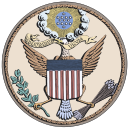Rhode Island in the American Civil War
 |
|
Union states in the American Civil War |
|---|
|
|
| Dual governments |
| Territories and D.C. |
|
The state of Rhode Island during the American Civil War remained loyal to the Union, as did the other states of New England. Rhode Island furnished 25,236 fighting men to the Union Army, of which 1,685 died.[1] The state used its industrial capacity to supply the Union Army with the materials needed to win the war. Rhode Island's continued growth and modernization led to the creation of an urban mass transit system and improved health and sanitation programs.
Rhode Island during the war

Fort Adams near Newport was used temporarily as the United States Naval Academy. In May 1861, the Academy was moved to Newport from Annapolis, Maryland due to concerns about the political sympathies of the Marylanders, many of whom were suspected of supporting the Confederate States of America. In September, the Academy moved to the Atlantic House hotel in Newport and remained there for the rest of the war.[2]
In 1862, Fort Adams became the headquarters and recruit depot for the
Notable leaders from Rhode Island
Politics
Senator Henry B. Anthony was born in Coventry, Rhode Island. He was a powerful newspaper owner and staunch advocate of the policies of President Lincoln during the Civil War. Rhode Island Senator Samuel G. Arnold of Providence was also a Republican; he served in the Union Army until 1862, when he was elected to fill the vacancy caused by the resignation of James F. Simmons.
Rhode Island Governor
-
Senator Henry B. Anthony
-
Governor William Sprague IV
-
Senator Samuel G. Arnold
Military
Ambrose Burnside was an arms manufacturer, politician, and general in the Rhode Island state militia and was an influential army officer. He rose to command of the Army of the Potomac before his disastrous defeat at the Battle of Fredericksburg in December 1862. He later commanded the Department of the Ohio as well as the IX Corps. His field duty ended during the siege of Petersburg with the Battle of the Crater, another fiasco for which he took the blame.[5]
Major General
Brigadier General
-
Major General Silas Casey
See also
References
Notes
- ^ Dyer's Compendium
- ^ a b Fort Adams official website
- ^ This article incorporates text from the public domain Dictionary of American Naval Fighting Ships.
- ISBN 0-313-28093-2.
- ^ Eicher, pp. 155-56.
- ^
 One or more of the preceding sentences incorporates text from a publication now in the public domain: Wilson, J. G.; Fiske, J., eds. (1891). Appletons' Cyclopædia of American Biography. New York: D. Appleton.
One or more of the preceding sentences incorporates text from a publication now in the public domain: Wilson, J. G.; Fiske, J., eds. (1891). Appletons' Cyclopædia of American Biography. New York: D. Appleton. {{cite encyclopedia}}: Missing or empty|title=(help) - ^ Casey Biography from US Regulars Archive Archived 2008-09-15 at the Wayback Machine
- ^ Warner, p.
- ^ Rhode Island Civil War Round Table bio of Arnold
- ISBN 978-0-87611-226-7.
- ^ Motts, pp. 63-75.
- ^ Eicher
- ^ Eicher, Warner
- ^
 This article incorporates public domain material from websites or documents of the Naval History and Heritage Command.
This article incorporates public domain material from websites or documents of the Naval History and Heritage Command.
Further reading
- Denison, Frederic. Sabres and Spurs: The First Regiment Rhode Island Cavalry in the Civil War (1876) online
- Dyer, Frederick H., A Compendium of the War of Rebellion: Compiled and Arranged From Official Records of the Federal and Confederate Armies, Reports of the Adjutant Generals of the Several States, The Army Registers and Other Reliable Documents and Sources, Des Moines, Iowa: Dyer Publishing, 1908 (reprinted by Morningside Books, 1978), ISBN 978-0-89029-046-0.
- Grandchamp, Robert. Rhode Island and the Civil War: Voices from the Ocean State (2012) excerpt
- Gryzb, Frank L. Hidden History of Rhode Island and the Civil War (2013) excerpt
- Gryzb, Frank L. Rhode Island's Civil War Hospital: Life and Death at Portsmouth Grove, 1862-1865 (2012) excerpt
- Hopkins, William Palmer, and George B. Peck. The Seventh Regiment Rhode Island Volunteers in the Civil War, 1862-1865 (1903) online
- Marvel, William. Burnside (U of North Carolina Press, 1991) Scholarly biography of the state's most famous soldier, General Ambrose Burnside.
- Miller, Richard F. ed. States at War, Volume 1: A Reference Guide for Connecticut, Maine, Massachusetts, New Hampshire, Rhode Island, and Vermont in the Civil War (2013) excerpt
- Rable, George C. Index to The Fourteenth Regiment Rhode Island Heavy Artillery (Colored,) in the War to Preserve the Union, 1861-1865. (2021).
- Rhodes, Robert Hunt. All for the Union: The Civil War Diary of Elijah Hunt Rhodes. (Orion Books, 1985), a famous diary of a Rhode Island soldier
- Spicer, William Arnold. History of the Ninth and Tenth Regiments Rhode Island Volunteers, and the Tenth Rhode Island Battery, in the Union Army in 1862 (Providence: Snow and Farnham, 1892).
- Williams, Frank J. and Patrick T. Conley. The Rhode Island Home Front in the Civil War Era (2013) excerpt









